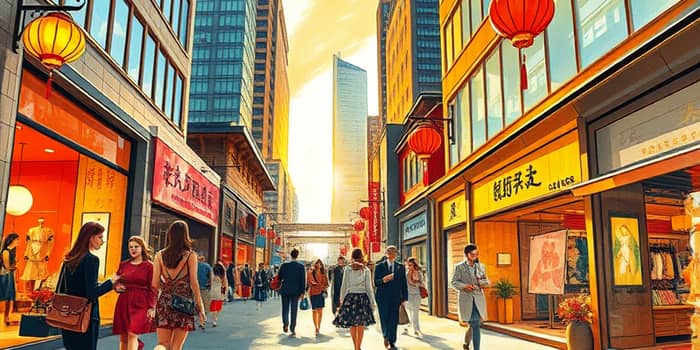
In recent years, the Asia-Pacific luxury goods market has witnessed an unprecedented surge, reaching USD 141.82 billion in 2023 and poised to hit USD 187.38 billion by 2033. This growth is not merely statistical; it represents a dramatic rise in high-net-worth individuals and an evolving consumer landscape that demands innovation and adaptability from luxury houses worldwide.
China leads the charge as the largest and most dynamic market, rebounding robustly from pandemic-induced slowdowns. Simultaneously, emerging markets such as India and Southeast Asia are carving out significant space in the luxury sphere, fueled by urbanization and an expanding upper-middle class. These shifts are reshaping global strategies and heralding a new era for high-end brands.
For industry stakeholders, understanding these nuances is essential. This article delves into the multifaceted drivers of demand, category-specific trends, brand strategies, and the challenges ahead. By offering actionable insights for market engagement, we aim to guide luxury brands in navigating this vibrant and complex environment.
Beyond China’s headline figures, other regions are experiencing rapid expansion. Japan remains a mature, stable market with strong demand for fashion, watches, and jewelry. South Korea’s tech-savvy consumers, influenced by entertainment and K-fashion, are driving high-end sales. Meanwhile, India’s affluent class is growing at a double-digit CAGR, with luxury brands tailoring their offerings to regional tastes and wedding traditions.
Southeast Asia also presents a fertile ground for luxury expansion. Urbanization, rising disposable incomes, and a youthful demographic are combining to create new customer segments. Tier 2 and 3 cities across the region are particularly important, as they often offer less-saturated markets where brands can establish a strong foothold early.
Multiple factors converge to propel luxury demand in Asia. First, the accumulative savings amassed during the pandemic have led to pent-up consumer demand for luxury, particularly in China where the average saving rate reached 33.5% in 2022. Second, the growing number of high-net-worth individuals and an expanding upper-middle class continue to elevate spending power and aspirational behavior.
Urbanization, especially in smaller cities, is unlocking new customer segments. As consumers move to urban centers, they embrace global trends and seek premium experiences. Finally, a shift towards sustainability and customization is reshaping purchase criteria, with buyers demanding ethically sourced materials, personalized craftsmanship, and limited-edition pieces.
Not all luxury categories are growing at the same pace. In early 2023, China’s retail growth showcased a staggering 48% increase in gold and jewelry, 34% in cosmetics, and 13% in apparel. Swiss watch exports to China soared by 68%, reflecting an insatiable appetite for heritage craftsmanship and precision engineering.
Jewelry brands are capitalizing on cultural traditions and milestone celebrations, creating bespoke collections for weddings and festivals. Beauty houses are innovating with localized formulations and exclusive product lines for Asian skin and beauty preferences. Meanwhile, fashion labels are experimenting with limited-run collaborations and pop-up experiences to maintain exclusivity and desirability.
To win in this dynamic landscape, luxury brands are embracing a multi-pronged approach. Localization is key: brands like Hermès have launched the Shang Xia label to blend Chinese craftsmanship with global design. Louis Vuitton has expanded flagship stores in India, tailoring offerings for weddings and festivals.
Digital transformation underpins modern strategy. Advanced AI-driven personalization, immersive e-commerce platforms, and engaging social media storytelling enable brands to connect with tech-savvy consumers. From virtual try-ons to concierge services via chatbots, the marriage of technology and luxury service is redefining the shopping journey.
Moreover, sustainability is no longer optional. Brands are integrating ethical sourcing, eco-friendly packaging, and carbon-neutral initiatives into their core messaging. This not only meets consumer expectations but also strengthens brand reputation and long-term viability.
Despite robust growth, the luxury sector in Asia faces headwinds. Economic volatility in China and currency fluctuations can impact pricing strategies and profit margins. New tariffs and global inflationary pressures require brands to maintain flexibility in their supply chains and pricing models.
Competition in lower-tier cities is intensifying, demanding hyper-localized strategies and nimble market testing. Brands must balance exclusivity with accessibility, ensuring that expansion does not dilute their luxury cachet. Continuous investment in consumer insights and agile marketing is essential to stay ahead of shifting preferences.
Looking forward, experts forecast sustained mid-single-digit growth across key Asian markets, with potential for 35-40% sales growth in China if pent-up demand persists. For brands, the priority will be to:
By combining strategic foresight with operational agility, luxury brands can harness the full potential of Asia’s booming market. The journey requires creativity, cultural sensitivity, and a steadfast commitment to excellence.
For industry professionals, investors, and brand strategists, understanding these dynamics is critical. Embrace localized engagement, leverage cutting-edge technology, and champion sustainable practices. In doing so, you will not only capture market share but also foster lasting loyalty among Asia’s discerning consumers.
Asia’s luxury market narrative is one of transformation. From rebound spending to sustainable luxury demands, each trend offers a roadmap for growth. Brands that listen intently to consumer voices, innovate with purpose, and honor cultural contexts will emerge as the true victors in this vibrant landscape. The future of luxury in Asia is brighter than ever, and the opportunities are ripe for those ready to adapt and excel.
References













